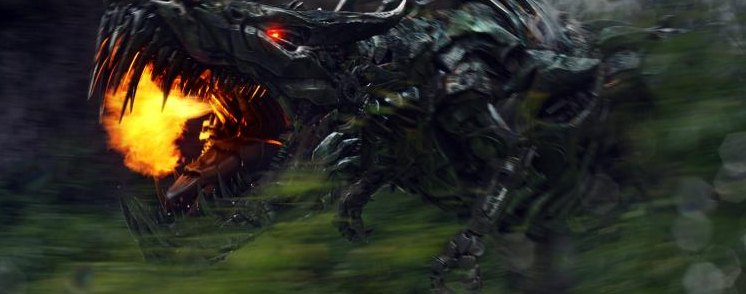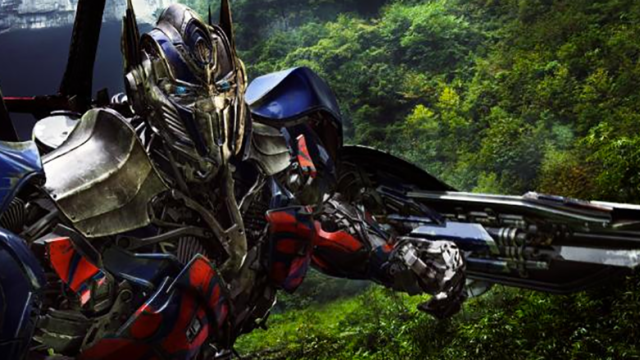If you see Transformers: Age of Extinction, the fourth (fourth!) film in the franchise this weekend, you’re not going to see an emotional tale of robots banding together to overcome adversity. You’re going for the badass special effects. We chatted with VFX supervisor Scott Farrar to see how the new movie made them more awesome than ever.
In Age of Extinction, the Autobots are more intricate, they’re bigger, more detailed, and more realistic. And the 165-minute movie is mostly robot action, rather than Mark Whalberg spilling his soul. Farrar, who is a long-time veteran of ILM (the visual effects company started by George Lucas in 1975 to work on the original Star Wars), and whose VFX credits include World War: Z, Hunger Games, Back to the Future, all four Transformers flicks, as well as more than 40 other films, told us a little bit of the back story.
How were the techniques different with Age of Extinction when compared with the other three Transformers movies?
Farrar: We’ve all been students of how to make the Transformers characters look more real, more metallic, better acting, more photographically real in each of the films. Certainly the robots look better than they have before in this one. They’re sharper, the colours are more detailed, and the biggest change is, I think, the large amount of work that we had that was all robots, lots and lots of shots in the film don’t have human actors in them at all. In fact, our work accounts for about 90 minutes of the movie. It’s data-heavy, it’s the largest film I’ve ever done, and it’s the largest data push through in ILM history.

What kind of work goes into making just one Transformer?
Let me break it down this way: To do one model takes roughly — it could be less, it could be more — 15 weeks. So you start with artwork, and lots and lots of designs and artwork that are photoshopped in 2D. Then we turn [the art] into a 3D character and all of its little pieces have to be built. Optimus has over 10,000 pieces in him, for instance, and each one of those pieces has to be modelled correctly. It’s easy to make a box or a rectangle in the computer but it’s very hard to do compound curves — that’s what is time consuming. Every [model] has to be painted. So we have an entire ILM paint staff, which started over a year and a half ago just to get the models ready so we can have them ready to be put in a shot.
After that you get the models done, you kind of like the way it looks, then you rig it. That’s the internal skeleton, and that takes another 15 weeks because there are so many little pieces — the joints and the swivels and so forth that allow the animators to make all the little mechanisms move and turn and spin and flip. Then finally you’re ready to put them in a shot, and at that point you still spend about six months fine-tuning the look of the character.

Are you not using pre-made models from previous Transformers films?
We start with the older models. One thing that’s happened is the software changes, and we have to do updates and sometimes what we used to have won’t run on current software, so conversions have to be made. But in each one of these movies, you will see a difference in the characters.
For instance, look at Bumblebee. He got more refined, he’s sleeker, he’s buffed-out, he’s stronger-looking. His shoulders got wider. It’s exactly the same as we do with all the GM vehicles. Like the Camaro has undergone a lot of changes as you look through the years. All the models themselves, by the same token, we revamp to make them look cooler and better each time.
Has creating characters in CGI gotten easier, or are you making the characters more intricate?
It’s gotten harder. [The Transformers] are more dense, they have more pieces, and the look and style of each one is more complex. Let me give you an example: In this film, Optimus Prime undergoes three different character changes because he gradually becomes an updated version of a knight, a knight formation. His shoulders, his helmet, his facemask and the cuffs on his sleeves, and lots of different details and chest pieces all revamp throughout the movie.
Then in addition to that, he’s got four levels of damage and each one of those has to be created. If there’s a slice or a cut or a hit or a bullet hole, all those are a change in the model. So then it gets to be an unbelievable game of trying to keep track of ‘where are we with each model?’, especially when you’re cutting back and forth between shots. Then, ‘alright, which model variation are we supposed to be using?’ We have this whole game plan based on where the shots fall in the sequence.
It must be interesting to do the visual effects on films like Transformers because the characters are changing so much by their very definition.
It is! Well, it’s also given us a great opportunity to make these things look as photoreal as possible. One thing I really enjoy about Transformers is [director Michael Bay] prefers to shoot as many background places as possible that are real locations… Our style is a different approach from [a lot of] films, [because we] start with real backgrounds.
We shoot actually in Detroit and Chicago and Hong Kong and Beijing. And with those backgrounds, with those real buildings, the expectation is for all the robots to look as photographically real as possible. Therefore the lighting is critical. I spent every day all day long just working on mostly the lighting so that it looks like a theatrical piece, like a normal film that you’re used to seeing.
What percentage of the four cities we see in Age of Extinction are real and what are CGI?
Every single cityscape is real. Let’s talk about Chicago, the aerials. We developed a new camera, we’re developing new camera rigs, we use every toy and tool there is in the business to photograph these movies. We use the latest rigs, and I shoot a lot from a helicopter. We’ve developed a new rolling gimbal to mount on the helicopters so it looks like you’re roving and you’re turning and you’re banking through the turn around all the buildings in Chicago, which are real places, all actually shot from the helicopter. Likewise, Hong Kong.
A lot of ground scenes ares shot from a Porsche Cayenne that has a gimbal arm above it. It can go 145km/h down the street and you can get a lot of shots. However, there are certain scenes, like Optimus galloping down the streets of Hong Kong, where what we shot maybe didn’t exactly look the way we wanted it. So all those backgrounds are built from actual photographs. So it’s not CGI, it’s actually photography that we stitch together and we animate in the fashion that we want. So we can, for instance, create a corridor that’s a mile-long stretch of real buildings and fly the cameras through that area — and it will look 100 per cent photoreal.
